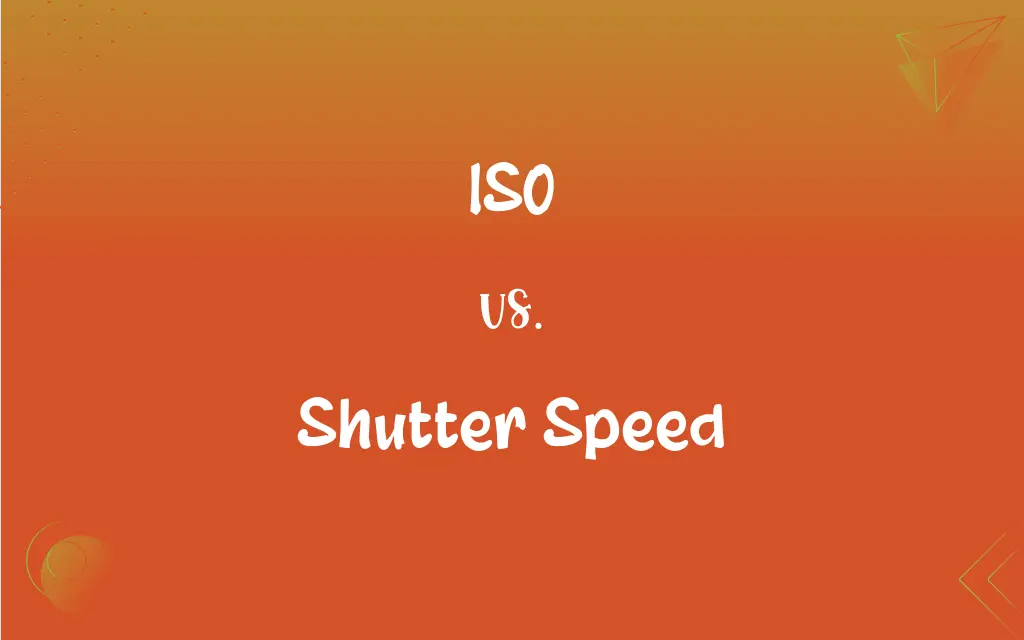ISO vs. Shutter Speed: What's the Difference?
Edited by Aimie Carlson || By Janet White || Published on February 24, 2024
ISO measures a camera's sensitivity to light; higher ISO increases brightness. Shutter speed is the time a camera's shutter is open; faster speeds freeze motion.

Key Differences
ISO determines how sensitive the camera's sensor is to light, affecting the brightness of the image. Shutter speed controls the duration the camera's shutter remains open, influencing motion blur and exposure.
Adjusting ISO is crucial in low-light conditions to brighten images, but higher ISO can introduce noise. Shutter speed adjustments are key for capturing motion, with faster speeds freezing action and slower speeds creating blur.
In sports photography, a fast shutter speed is essential to capture fast-moving subjects without blur. High ISO settings are often used in indoor or night photography to compensate for low light.
Increasing ISO can lead to grainy pictures, especially at very high values. A very slow shutter speed can result in camera shake or motion blur, requiring a tripod for stability.
Lower ISO levels are preferred for clear, noise-free images. Creative uses of shutter speed include long exposures for light trails or water effects and high speeds for crisp action shots.
ADVERTISEMENT
Comparison Chart
Primary Function
Adjusts camera sensor's light sensitivity.
Controls the duration of light exposure.
Impact on Image
Affects image brightness and noise level.
Influences motion blur and exposure.
Typical Adjustments
Increased in low light, decreased in bright.
Fast for freezing action, slow for blur.
Common Applications
High in low light, low for clear images.
Varied speeds for different motion effects.
Creative Techniques
Lower for sharp, clear images; higher for artistic effects.
Long exposures for blur, fast for crisp action.
ADVERTISEMENT
ISO and Shutter Speed Definitions
ISO
A tool to brighten or darken a photo.
He adjusted the ISO to lighten the photograph on the overcast day.
Shutter Speed
Can create artistic effects like light trails.
She used a long shutter speed at night to capture the city's light trails.
ISO
Higher ISO leads to more image noise.
Avoiding high ISO, she opted for additional lighting to maintain image quality.
Shutter Speed
Faster speeds freeze action; slower speeds create blur.
For the sports event, a high shutter speed was essential to capture clear shots.
ISO
Measures camera sensor's sensitivity to light.
To capture the dimly lit scene, she increased the ISO.
Shutter Speed
Controls motion blur in photographs.
Capturing the waterfall's movement, she chose a slower shutter speed.
ISO
Lower ISO for clearer, sharper images.
For the landscape shot, a low ISO ensured crisp details.
Shutter Speed
Time duration the camera's shutter is open.
To freeze the fast-moving car, he set a quick shutter speed.
ISO
Vital for photography in various lighting.
In the brightly lit room, she reduced the ISO to prevent overexposure.
Shutter Speed
Affects overall exposure of the image.
In bright sunlight, he used a faster shutter speed to avoid overexposure.
ISO
An organization, the International Organization for Standardization, that sets standards in many businesses and technologies, including computing and communications.
ISO
(colloquial) isolation
ISO
Quarantine measures in order to mitigate the spread of communicable diseases, such as Covid-19.
ISO
An isolation play in basketball or American football.
ISO
(category theory) isomorphism
FAQs
Is a low or high ISO better?
A low ISO is generally better for image quality, producing clearer and sharper images with less noise.
What does ISO stand for in photography?
ISO stands for International Organization for Standardization, reflecting the standard scale for measuring light sensitivity.
Can you change shutter speed on all cameras?
Most cameras, especially DSLRs and mirrorless models, allow you to manually adjust shutter speed.
How do I choose the right ISO?
Choose ISO based on lighting conditions and the desired balance between image brightness and noise.
How does shutter speed affect a photo?
Shutter speed affects motion blur and exposure; faster speeds freeze action, while slower speeds can create blur.
When should I use a high ISO setting?
Use a high ISO in low-light conditions or when you can't use a slower shutter speed or wider aperture.
Can ISO affect exposure?
Yes, ISO directly affects the exposure of a photo by altering the camera sensor's sensitivity to light.
What happens if ISO is too high?
If ISO is too high, it can lead to grainy or noisy images, especially in darker areas.
Does ISO affect color?
High ISO can sometimes affect color accuracy, making images appear grainier and less vibrant.
Does changing ISO affect depth of field?
Changing ISO does not directly affect depth of field; depth of field is primarily controlled by aperture.
Can ISO be adjusted in post-processing?
While exposure can be adjusted in post-processing, it's better to set the correct ISO in-camera for optimal quality.
What is a good shutter speed for portraits?
A good shutter speed for portraits is typically around 1/60th to 1/200th of a second to avoid blur.
Is there a perfect shutter speed?
There's no universally perfect shutter speed; it depends on the subject, lighting, and desired effect.
What shutter speed should I use for sports?
For sports, a fast shutter speed like 1/500th of a second or faster is ideal to freeze motion.
Does a tripod help with slow shutter speeds?
Yes, a tripod stabilizes the camera, allowing for sharp images at slower shutter speeds without blur from hand movement.
What's the effect of a very fast shutter speed?
A very fast shutter speed can freeze even the fastest moving subjects, like in sports or wildlife photography.
What shutter speed blurs water movement?
To blur water movement, use a slower shutter speed, like 1/15th of a second or slower.
What ISO is best for night photography?
Higher ISO values, like 800 or above, are often used in night photography, but balancing with noise is key.
Is a lower shutter speed better in low light?
A lower shutter speed can help in low light by allowing more time for light to hit the sensor, but it may require a tripod to avoid blur.
What's the relationship between shutter speed and aperture?
Shutter speed and aperture work together to control exposure; a faster shutter speed requires a larger aperture for the same exposure level.
About Author
Written by
Janet WhiteJanet White has been an esteemed writer and blogger for Difference Wiki. Holding a Master's degree in Science and Medical Journalism from the prestigious Boston University, she has consistently demonstrated her expertise and passion for her field. When she's not immersed in her work, Janet relishes her time exercising, delving into a good book, and cherishing moments with friends and family.
Edited by
Aimie CarlsonAimie Carlson, holding a master's degree in English literature, is a fervent English language enthusiast. She lends her writing talents to Difference Wiki, a prominent website that specializes in comparisons, offering readers insightful analyses that both captivate and inform.






































































